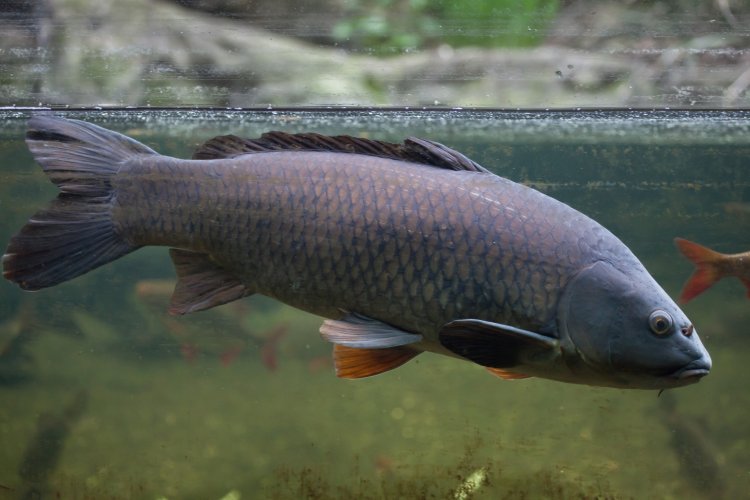Mikhail Ivanovich Gladyshev. Photo: screenshot from an interview with Scientific Russia
Why fish is scarce in the northern lakes and why is it considered a healthy food? How is the imbalance of omega-3 and omega-6 polyunsaturated fatty acids associated with cardiovascular diseases? Mikhail Ivanovich Gladyshev, a Corresponding Member of the Russian Academy of Sciences, Head of the Laboratory of Experimental Hydroecology at the Institute of Biophysics of the Siberian Branch of the Russian Academy of Sciences, Head of the Department of Aquatic and Terrestrial Ecosystems of the Siberian Federal University, answered these and many other questions.
─ It is believed that fish is plentiful in the North. Is it true?
─ I would say this is a popular misconception. Fish is plentiful in the North if you don’t catch it: the northern Arctic ecosystems are oligotrophic by nature, that is, few in nutrients, they have very low production. If you come to a northern lake, where no human has set foot, then there will be a lot of fish there for the first casting of nets, but you need to understand that this fish has been growing for many years, and after catching it once, you can no longer expect such a rich catch next year.
In the northern ecosystems, there is very low primary production, that is, low production of phytoplankton and phytobenthos (algae): due to low temperature, algae cannot photosynthesize and grow well. In addition, very few elements of mineral nutrition, the so-called biogens, nitrogen and phosphorus, enter these lakes from the drainage basin. Therefore, the rate of primary production, the rate of photosynthesis in all oligotrophic lakes (not only in the Arctic but also in the mountains) is low.
In the northern lakes with clear water, by definition, there can be no high production. Large biomass of fish can grow in them, but the production of biomass per unit of time is something else, and it is necessary to clearly distinguish the harvest at the root (biomass reserves of a specific area, determined in each period) and the time in which this harvest grows. In low-feeding lakes, fish grow slowly, and if it reaches large biomass, then the next time after catching it, it will reach this large biomass only after many, many years.
The very concept of production was introduced into scientific discourse in the 1930s by Corresponding Member of the USSR Academy of Sciences G.G. Vinberg, he clearly showed its difference from biomass. A person cannot eat biomass, they can only eat products, i.e., production. But what is production? This is the additional biomass that has grown over a certain period, that can be extracted from the ecosystem without undermining its reserves: that is, it can be caught and eaten, while the production capacity of this biomass will remain. This is the basis for the entire system of allowable catches and quotas for catching fish and other seafood.
Steppe and grassy ecosystems have the highest net production on Earth. But if we take tropical forests with their huge biomass (it is many times more than in the forest and in the steppe of the middle latitudes), then there is zero net production. Because in the tropics, what is photosynthesized during the day, the same amount is consumed by the ecosystem at night. Therefore, those tribes that lived in the tropics remained at the Stone Age level, and human development took place where there was a high net production, where it was possible to withdraw food from the ecosystem without damage.
Northern low-feeding, that is, low-productive lakes need to be exploited with extreme caution, to calculate exactly how much fish we can withdraw in a certain period.
─ In the Russian North, in particular, in the Krasnoyarsk Krai, are there lakes and rivers still untouched by man?
─ There are plenty of untouched lakes and rivers. Let’s recall the same famous Taymyr Reserve: by definition, nothing can be touched there. There are hundreds of thousands of lakes in the Arctic, and there is more water than land in the tundra: there is generally more water than land in the polar tundra. Of course, countless lakes and rivers have been preserved in the North, but they are all oligotrophic, low-productive.
─ Do you think fish must be present in the human diet?
─ Yes, and this is due to the balance of omega-3 and omega-6 polyunsaturated fatty acids (PUFAs).
I’ll start from afar. In 1982, Swedish and British scientists Bengt Samuelsson, Sune Bergström, and John Vane received the Nobel Prize for discoveries concerning prostaglandins and related biologically active substances. We are talking about the so-called endohormones (now they are more often called oxylipins) – these are signaling molecules that regulate many functions of the body: they start or stop the inflammatory process, an allergic reaction, are responsible for the narrowing and expansion of blood vessels, platelet aggregation – that is, for blood pressure, the work of the cardiovascular system. The biochemical precursors of these endohormones are the so-called long-chain polyunsaturated fatty acids. The two main acids from which these endohormones are synthesized are arachidonic acid (ARA) of the omega-6 family and eicosapentaenoic acid (EPA) of the omega-3 family.
From omega-6 ARA, for example, thromboxanes of the second series are synthesized, which constrict blood vessels and increase platelet aggregation, that is, increase blood pressure, or prostaglandins of the second series, which trigger a regenerative reaction. And from its counterregulator, EPA, omega-3 acids, endohormones are synthesized that have the opposite effect: they dilate blood vessels, reduce platelet aggregation, that is, blood pressure, and have an anti-inflammatory effect. So, this whole regulatory system works like an accelerator and brake pedals in a car: if one of the pedals is absent, the car will not be able to move normally, and the body will not function.
The human genotype is initially set to the ratio of omega-3 and omega-6 one to one. It is with this balance that our body functions normally: then inflammation and pain do not kill us, but, on the contrary, heal us (in particular, from infections).
It is noteworthy that in the human body, especially in representatives of the Caucasian race, ARA and EPA, and another important regulator from the omega-3 family, docosahexaenoic acid (DHA), are very poorly synthesized from biochemical precursors of short-chain omega-6 and omega-3 acids, and we must definitely get ARA, EPA, and DHA with food.
In the mid-1950s, when the industrialization of agriculture took place, meat products grown on grain-rich feeds with a high content of short-chain omega-6 acids began to predominate in the human diet. Thus, the ratio of omega-6 and omega-3 acids became not one to one, but 20 to one (!), which greatly contributed to the development of cardiovascular diseases.
In fact, the epidemic of cardiovascular diseases is our payback for satiety. Thanks to the rapid development of agriculture, humanity ate enough for the first time, but it ate, roughly speaking, hamburgers and grain, moving away from green grass (which contains the precursor of long-chain omega-3 polyunsaturated fatty acids – short-chain α-Linolenic acid) and pasture animal husbandry.
─ And if a person, for example, does not eat meat, but consumes only seafood, fish, then these problems of the omega-3 and omega-6 imbalance will not affect them?
─ You are absolutely right. When the epidemic of cardiovascular diseases struck Europe and the United States, it quickly became clear that Eskimo, in principle, do not suffer from cardiovascular diseases, and the Japanese have very few cases – and both eat mainly seafood. Scientists began to ponder: what’s the matter? At first, it was assumed that it was cholesterol, but then this hypothesis faded into the background, and the idea of the regulatory role of long-chain omega-3 acids came to the fore – these are the already mentioned EPA and DHA, that fish is so rich in.
By the way, on earth, there are no such acids in terrestrial food, because plants synthesize only short-chain acids, with 18 carbon atoms. And long-chain omega-3 acids with 20 and 22 carbon atoms, EPA and DHA, synthesize only some types of microalgae, then they are transferred along the food chain to fish and accumulate there. So, fish is the main source of EPA and DHA for humans.
According to a long-term study by scientists from the Institute of Cytology and Genetics SB RAS, tundra inhabitants are less likely than Southerners to suffer from diabetes mellitus, as well as cardiovascular diseases. However, diseases such as opisthorchiasis (parasitic disease), tuberculosis, and esophageal cancer are more common among Chukchi and Eskimo. Photo: moodboard / 123RF
─ But what about linseed oil, which is often recommended as a source of omega-3?
─ No terrestrial plants can synthesize EPA and DHA – the precursors of endohormones. Linseed oil, as well as, for example, rapeseed and camelina oil, contains only alpha-linolenic acid with 18 atoms from omega-3, it is a precursor of eicosapentaenoic acid. In principle, we can synthesize eicosapentaenoic acid from this acid, but our synthesis is ineffective and covers only 5% of the physiological needs of the body in long-chain acids! This means that alpha-linolenic acid from linseed oil, which you use (and, by the way, you are doing right), is burned by 90%, and only 5% goes to the synthesis of EPA, at best… not to mention docosahexaenoic acid. Therefore, the World Health Organization and a number of scientific medical societies of different countries have recommended daily consumption of one gram of eicosapentaenoic and docosahexaenoic acid, which only fish contains, for the prevention of cardiovascular diseases. In the oil of terrestrial plants, it simply does not exist. When you come to the pharmacy and see pills there that say “Omega-3-acids,” you can ask: “What are these acids? How many carbon atoms are there in them?” If it’s 18-atom alpha-linolenic acid, it won’t be of any use. But if it is eicosapentaenoic and docosahexaenoic acid, then everything is fine.
Reference. Eicosapentaenoic acid (EPA) improves blood properties, reduces thrombosis and deposition of cholesterol plaques. Together, DHA and EPA reduce the risk of acute cardiovascular diseases, the likelihood of thrombosis, normalize cholesterol levels, stimulate weight loss, improve the reproductive health of men and women, increase work efficiency.
─ It turns out that linseed oil and the like are not suitable. And fish oil? How to find the fish oil that can cover our need for EPA and DHA?
─ Eicosapentaenoic and docosahexaenoic acids, the precursors of endohormones, are not contained in the oil that comes from fish. Fish oil is a spare nutrient, the so-called triglycerides, non-structural spare components. But the acids from which endohormones are synthesized are structural elements of cell membranes, phospholipids, that is, they are contained in cell membranes and do not go anywhere. Accordingly, most EPA and DHA are found in fish meat, that is, in tissues that consist of cells, and not in those triacylglycerides, spare lipids that come from the fish.
If the fish oil that comes from the fish is collected and sold in the form of capsules, this does not mean that it is omega-3 acids. But if they are made in a special way, then capsules are available for sale, which really contain a high recommended daily dose of EPA and DHA, but they cost quite a lot of money. And it’s easier, for example, to eat 40 grams of saury, one can of which contains 5 daily doses of EPA and DHA, than to buy these pills. In addition, the human digestibility of EPA and DHA obtained together with fish meat, for example, with the same canned saury, is threefold better than the digestibility of acids contained in pills.
If you still decide to buy fish oil at a pharmacy, then note that the label should indicate exactly eicosapentaenoic and docosahexaenoic acids. And, of course, it must be some trustworthy company with a good reputation, with a good background.
─ It is believed that fish accumulates harmful substances, such as mercury. Is this really so?
─ Fish is at the top of the trophic chain, which starts from algae. Indeed, fish, in addition to accumulating EPA and DHA, also accumulates heavy metals, pesticides, and radionuclides, and this is a big problem in polluted areas of the ocean and polluted inland reservoirs and watercourses. Of course, there is a great danger that by eating fish as a valuable product with biologically active PUFA, we can also pick up radionuclides and heavy metals. Therefore, it is necessary to conduct environmental monitoring of water areas. But in general, in this matter, again, balance is important.
It is believed that carp family fish accumulate mercury to a lesser extent. Predatory fish, especially tuna, accumulate heavy metals to a greater extent. The record holder for the accumulation of mercury among the inhabitants of Russian inland reservoirs is perch. The higher the fish is in the food pyramid, the more useful PUFA and harmful heavy metals are in it. Photo: wrangel / 123RF
In 2008, my colleagues and I from the Institute of Biophysics SB RAS and the Trade and Economic Institute (Krasnoyarsk) proposed a special formula for assessing the risk-benefit ratio in fish, depending on the content of heavy metals and PUFA. Knowing the portion of fish that is needed for a healthy diet, we can immediately calculate the risks: and how many heavy metals are contained in this portion? Our formula is now widely used all over the world, scientists in more than ten countries use it for their calculations.
In addition, we monitored canned food: we checked, for example, the same saury; and it was found that if you consume 40 grams of meat a day, you will not receive any dangerous dose of heavy metals. We also monitored grayling in the Yenisei River, this fish is almost always safe, but still, there were isolated cases when the risk outweighed the benefit due to the high chromium content. That is, even in relatively ecologically safe aquatic ecosystems, monitoring the quality of fish products is necessary.
If we talk about mercury, 6 years ago, together with a large group of scientists from the USA, we published a review on the concentration of mercury, selenium, and PUFA in the fish of the World Ocean. The work was presented in the Journal of the Marine Biological Association of the United Kingdom, one of the recognized leaders among marine biology journals. Even though there are some water areas where mercury exceeds all sanitary standards, in most water areas the danger of mercury is still greatly exaggerated. But once again, this requires constant monitoring. Indeed, such a danger exists, but whether it exists in this type of fish caught in this water area – this needs to be looked at separately and carefully every time. Because, if we take statistics, there are not so many such water areas.
I believe that eating fish should be promoted. It is known that in Russia almost half of the deaths are associated with cardiovascular diseases. At the same time, it has been proven that getting EPA and DHA together with food, which are contained in fish, can reduce cardiovascular diseases mortality by at least 35%.
By themselves, meat and hamburgers are not poison, but to avoid harm, this meat in the diet needs to be balanced with fish. If a person eats, for example, 40 grams of saury or 50 grams of herring a day, then they will have a physiologically optimal, healthy balance of omega-3 and omega-6 PUFA.
RELATED LINKS:
● Benefit risk-ratio of food fish intake as the source of essential fatty acids vs. heavy metals: A case study of Siberian grayling from the Yenisei River/ Food Chemistry/ 2008.
● Mercury, selenium and fish oils in marine food webs and implications for human health/ Journal of the Marine Biological Association of the United Kingdom/ 2016.
● Незаменимые полиненасыщенные жирные кислоты и их пищевые источники для человека/ М.И. Гладышев/ Журнал Сибирского федерального университета/ 2012 г.
























